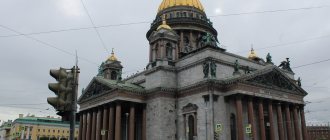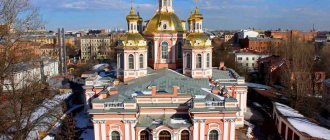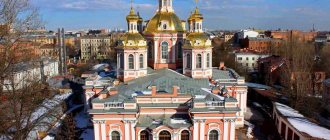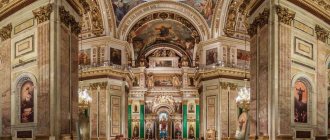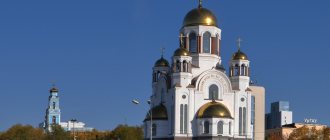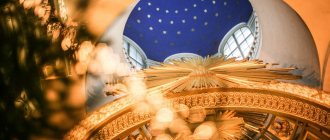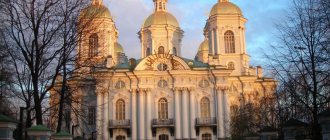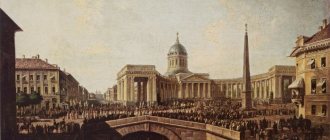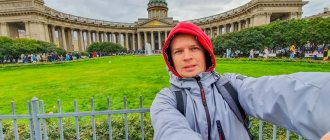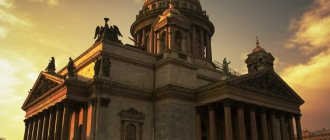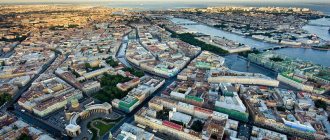St. Petersburg's cathedrals are an important part of its countless attractions. They lived the history of the city with their parishioners, they remember representatives of the imperial family and Russian classics. These churches suffered floods and fires, were closed and blown up by the Soviet authorities. Today, most of these churches are open to parishioners and tourists, and anyone can enter them.
Kazan Cathedral
This Orthodox church is a monument to Russian military valor. It is here that the legendary Mikhail Kutuzov is buried, and the captured banners of the defeated French army are kept here. The main shrine in the church is the Kazan Icon of the Mother of God, which has been in St. Petersburg since 1710. Believers believe that as long as this relic remains within the city, no foreign enemy will be able to enter here.
During the Patriotic War, Russian soldiers and officers and Mikhail Illarionovich himself prayed there. In front of the cathedral there is a square where monuments to Kutuzov and another commander, Barclay de Tolly, were erected in 1837. In April 1932, the city's main church was closed, and the name of the St. Petersburg Cathedral was changed to the Museum of the History of Atheism and Religion. Services were resumed on Trinity Sunday in 1991.
The church building was founded in August 1801 in the center of St. Petersburg, on Nevsky Prospekt, and its construction was completed almost before the very beginning of the Patriotic War. The creator of the cathedral, architect Voronikhin, used a number of non-standard solutions and innovations during construction, thanks to which the temple seems to open its arms to parishioners and visitors. The semicircular colonnade contains 96 marble columns.
Shrines[edit]
- icon of the image of our Lord Jesus Christ not made by hands
- list of the Kazan Icon of the Mother of God
- list of the icon of the Mother of God “Neva Quick to Hear”
- Icon of the Mother of God “The Sign”
- icon of the Annunciation of the Blessed Virgin Mary
- icon of the Assumption of the Blessed Virgin Mary
- icon of All Saints' Day in the Russian land who have shone
- icon blgv. book Alexander Nevsky
- icon of St. Nicholas the Wonderworker
- icon of St. Nicholas the Wonderworker with the life of the saint
- icon of St. Seraphim of Sarov
- icon of St. Sergius of Radonezh
- Elizabethan altar gospel
- blockade antimens
Vladimir Church
A famous architectural monument belonging to the Baroque style. Initially, the design of the temple was developed by Trezzini, but the construction took too long, and they had a hand in its construction:
- Melnikov;
- Golm;
- Kvarneghi;
- Ruska.
The church has five domes, and a high bell tower was erected next to it. The cathedral was founded in the summer of 1761, and the construction was completely completed only in 1769. The main shrine of the temple is the Vladimir Icon of the Mother of God, painted in the 18th century and which gave the name to the cathedral. There is also a valuable icon of Seraphim of Sarov with a piece of the robe of the great Russian saint. There are also other important icons and their lists.
In 1886, the domes were covered with gold, but in the 1930s the gold was washed off and everything was painted over with black paint. In 2014, gilding of the tops began again, and it was completely completed only by 2019.
Fyodor Dostoevsky loved to visit this old building in the last years of his life; the funeral service for A.S. Pushkin’s nanny, Arina Rodionovna, was held here. During the Soviet years, the church ceased to function; the Lenmashuchet factory operated in its building. It was returned to believers only in the summer of 1989. On April 7, 1990, the church underwent a consecration ceremony. In May 2000, it received the status of a cathedral. It has its own official website, like most St. Petersburg churches.
History[edit]
St. Petersburg, founded on May 16 (27), 1703, was almost immediately destined to become the capital of the country - Peter the Great was in a hurry to establish himself on the Baltic Sea. The new city is widely spread out in the Neva Delta - on the St. Petersburg, Moscow, and Vyborg sides. One of the first residential areas was occupied by a section of City Island along the banks of the Malaya Neva, west of the Peter and Paul Fortress. This area was called “Mokrusha” because it was often flooded during floods. According to legend, its first settlers already built a small church of St. around 1708. Nikola on Mokrusha. Later, in the 1710s, construction was carried out there of a three-altar mazanka church - the predecessor of the Prince Vladimir Cathedral. In its side aisles, Nikolsky and Predtechensky, services began in 1717. The main altar of the temple was consecrated in honor of the Dormition of the Mother of God on April 5, 1719. The rite was performed by the Locum Tenens of the Patriarchal Throne, Metropolitan of Ryazan and Murom Stefan (Yavorsky) in the presence of Peter I.
At the same time, by royal command, the temple received the status of cathedral. In its size and number of thrones, it even surpassed the earlier cathedrals of St. Petersburg, of which there were three at that time - Peter and Paul, St. Isaac's and Trinity-Petrovsky. The Fourth St. Petersburg Cathedral, recalling with its dedication the Great Assumption Cathedral of the Moscow Kremlin, emphasized the metropolitan status of the “young city” as the successor of Moscow. It is no coincidence that the courtyard of Metropolitan Stephen was built next to the new cathedral. From 1718, the Locum Tenens had to live almost constantly in St. Petersburg: this is how the city on the Neva became the center of not only civil, but also church government. In the St. Petersburg Assumption Cathedral, Peter the Great prayed in 1719-1724 during services on the days of the patronal feasts, the Assumption and St. Nicholas the “winter”. In the last years of the tsar’s life, two priests from the cathedral clergy - John of Vengrinovsky and Simeon of Yarmerkovsky - had theological education, and the entire “learned” clergy in the new capital then numbered 4 people. The tradition of building Assumption Cathedrals in Rus' dates back to the Kyiv period of its history: from Kyiv it moved to Vladimir, and then to Moscow. The “Great Church” of the Kiev-Pechersk Monastery, founded in 1073, is dedicated to the Dormition of the Mother of God. The celebration of the memory of its builders - 12 Greek masters - is included in the church calendar on February 14/27.
It was the Assumption Cathedrals of the three ancient Russian capitals that became the symbol of Holy Rus' - the “House of the Blessed Virgin Mary”. In 1740, by decree of Empress Anna Ioannovna, a stone church was founded next to the wooden Assumption Cathedral “on Mokrusha”. Architect P.-A. Trezzini designed it to be single-domed, modeled after the Cathedral of the Peter and Paul Fortress. In the second year of construction, there was a palace coup that brought Empress Elizabeth Petrovna to the throne. The building was brought under the vaults, but further funding for the work was stopped. The poor parish itself was content with its old church and could not bear the costs of constructing a stone cathedral with a capacity of 3,000 people.
Only in 1747, “Petrov’s daughter” ordered its completion to begin, and with a change in completion to a five-domed one “like in Moscow at the Assumption Cathedral.” Drawings were sent from Moscow, however, the new project was developed only during the reign of Empress Catherine II, in 1765. The competition was won by architect Antonio Rinaldi.
Like Aristotle Fioravanti, who three centuries earlier erected the Assumption Cathedral of the Moscow Kremlin, he was a native of Italy. In his project, A. Rinaldi, with rare skill, conveyed the composition of the ancient Russian source and achieved a unique harmony of the bell tower and the temple itself.
The five-domed cathedral on the St. Petersburg side was roughly rebuilt in 1766-1772. It took a central place in the panorama of the city, opening from the state rooms of the Neva enfilade of the Winter Palace, and its high pillar-shaped bell tower serves as a landmark for ships sailing from the bay to the Malaya Neva. In 1772, the wooden Assumption Cathedral, which had fallen into disrepair, was destroyed by fire. By that time, the stone church was still completely unfinished inside, so its vestibule was quickly adapted for services: there, on September 8 of the same year, the chapel of the same name was consecrated. This marked another long-term break in construction work. Meanwhile, the Russian Empire victoriously reached the shores of the Black Sea. On October 19, 1778, the city of Kherson was founded at the mouth of the Dnieper. It received its name in honor of ancient Chersonese (in Russian chronicles - Korsun) - a Crimean city, where in 988 the Grand Duke of Kiev Vladimir Svyatoslavich was baptized and married Princess Anna, the sister of the Byzantine emperors. With his wise steps, the prince, canonized by the Church, worthily introduced Kievan Rus into the circle of states of the Christian world. The struggle for the Black Sea borders in the 18th century could not help but revive the memory of St. Equal to the Apostles Prince Vladimir. On September 22, 1782, on the recommendation of Prince G.A. Potemkin's Empress Catherine II established the Order of St. Vladimir "to encourage military and civil service."
It was divided into 4 degrees and had the motto: “Benefit, honor and glory.” The order's ribbon consisted of three stripes: two black and a red one. Order of St. Vladimir I degree took place directly behind the Order of St. Andrew the First-Called - the highest award in Russia. Awarding the fourth degree of the order gave the right to hereditary nobility.
In the spring of 1783, an important historical event took place: on April 8, the Empress signed a manifesto on the acceptance of the Crimean Khanate under the Russian Empire. Crimea became the Taurida province, the coat of arms of which - a black Byzantine eagle with an eight-pointed cross in a shield on the chest - recalled the baptism of the “most glorious” Prince Vladimir there and his marriage to the princess of Constantinople. More than 40 years have passed since the foundation of the stone Assumption Cathedral in St. Petersburg. Finally, on May 31, 1783, Catherine II, “wishing that the Church of the Assumption of the Blessed Virgin Mary, begun long ago on the St. Petersburg side, would be completed,” issued a decree transferring its construction to the jurisdiction of Archbishop of Novgorod and St. Petersburg Gabriel (Petrov) - the chief director offices of the building of the Alexander Nevsky Monastery (since 1797 - Lavra). Thus, the final stage of work in the cathedral is associated with the masters of the circle of architect I.E. Starov, who carried out the monastery “structure” according to his designs. At the same time I.E. Starov developed plans for the cities of the Black Sea region, all management of which was entrusted to Prince G.A. Potemkin, and in St. Petersburg he built a princely palace, which soon received the name Tauride. Architectural assistant M.E. took direct control of the interior design of the cathedral. Melentyev - he approved all estimates. In 1787, Catherine II made a trip to the “midday countries of Russia”, visiting the Tauride region. The Empress generously distributed awards locally - the Order of St. Vladimir IV, III and even II degrees. And at the Kherson Admiralty, in her presence, three ships were launched, one of which was named “Vladimir”. When the finishing of the stone cathedral on the St. Petersburg side, which had been under construction for almost half a century, was completed in the capital, its main altar was consecrated on October 1, 1789, no longer in honor of the Dormition of the Mother of God, but in the name of St. Prince Vladimir.
Prince Vladimir Cathedral from a bird's eye view
Along with the Tauride Palace, the Prince Vladimir Cathedral marks Russia's acquisition of its baptismal font. The original dedication of the cathedral was preserved in the name of its Assumption Chapel. Later, another chapel was built in the temple - Nikolsky. Both chapels remained for a long time in small rooms on the sides of the vestibule and served only them in winter. Only in 1866-1867 were they moved to the side naves: Uspensky took the place to the right, and Nikolsky to the left of the main altar. At the same time, the entire cathedral was made warm. With the publication in 1845 of the new statute of the Order of St. Vladimir's cathedral became a cavalry cathedral (when the order was established, the St. Sophia Cathedral near Tsarskoye Selo was intended for its cavaliers). Since that time, at the request of the holders of the order, a tradition has developed in the Prince Vladimir Cathedral to celebrate the order's holiday on September 22 with a bishop's service, with prayer singing to the holy enlightener of Rus'. For the 100th anniversary of the establishment of the order, the cathedral was restored, and on September 22, 1882, many spiritual and secular Vladimir gentlemen gathered in the temple for the liturgy, which was performed by Metropolitan Isidor (Nikolsky) of St. Petersburg and Novgorod. The rector of the cathedral, Archpriest Alexy Svetlov, was awarded the Order of St. Vladimitra of the fourth degree. July 15, 1888, on the day of the celebration of the memory of St. Prince Vladimir, the whole country prayerfully remembered the 900th anniversary of the Baptism of Rus'. For the anniversary celebrations in the capital, a special ceremony was developed: the Prince Vladimir Cathedral became their focal point. Miraculous and especially revered icons from many St. Petersburg churches were delivered to it, and after the liturgy, a citywide religious procession headed from here across Tuchkov and the Nikolaevsky Bridge to the blessing of the waters to the Bronze Horseman. The majestic spiritual procession, grouped into 8 sections, stretched for almost two miles. On the anniversary of the 100th anniversary of the consecration of the main altar of the cathedral (October 1, 1889), Bishop Anthony (Vadkovsky) of Vyborg served there; later - Metropolitan of St. Petersburg and Ladoga) with archpriests - holders of the Order of St. Vladimir. He, in the rank of Archbishop of Finland and Vyborg, celebrated the liturgy in the cathedral on September 22, 1895, when the 50th anniversary of the conferment of cavalier status to the Prince Vladimir Cathedral was celebrated. In the summer of the war of 1915, church services and sermons on the occasion of the 900th anniversary of the death of St. Prince Vladimir. The Orthodox faith, which the Equal-to-the-Apostles Grand Duke planted in his power at the turn of the 10th-11th centuries, helped the peoples inhabiting Rus' to withstand and win - from generation to generation, in the most difficult historical trials. Divine services on July 14-15, 1915 in the Prince Vladimir Cathedral were led by the birthday boy of the day, Metropolitan of Petrograd and Ladoga Vladimir (Epiphany; later Hieromartyr-Metropolitan of Kiev).
By the late liturgy, religious processions from all over Petrograd arrived at the cathedral, and the holiday ended with the blessing of water on the Malaya Neva. The Order's holiday, celebrated in the cathedral in 1916, turned out to be the last... In 1875-1918, a parish charitable society operated at the Prince Vladimir Cathedral.
It continued the traditions of church charity, interrupted during the reign of Empress Catherine II (the first almshouse at the church was opened back in 1721). Since 1896, the society has been under the august patronage of Grand Duke Vladimir Alexandrovich, and since 1909 - his widow, Grand Duchess Maria Pavlovna. For a quarter of a century (1875-1900), the Chairman of the Society’s Council was one of its founders, a member of the City Duma, Ilya Ivanovich Sokolov. The society had its own wooden house (not preserved), in which it maintained a small orphanage, and during the First World War it opened a church infirmary with 16 beds. On the patronal feast of the cathedral (July 15, old style), after the liturgy, a religious procession was held along Alexander Avenue (now Dobrolyubov Avenue) to Birzhevoy Bridge and the building of the parish shelter. The cathedral belonged to the chapel of St. Alexander Nevsky at Tuchkov Bridge.
It was built with donations from parishioners in 1882-86 in memory of Emperor Alexander II the Liberator. The chapel was designed by architect N.N. Kovrigin, a member of the parish charitable society, brought it as a gift to the parish. The chapel was consecrated by Bishop Arseny (Bryantsev) of Ladoga on June 2, 1886. Ten years earlier, a square was laid out between the cathedral and the chapel (garden master E.L. Regel), which in 1881 received the name Prince of Vladimir; The area around the cathedral itself was also landscaped and fenced in 1871-1872. It is interesting that the initiator of these works was Emperor Alexander II personally: in 1870, he pointed out that the square at the cathedral “in appearance does not correspond to the external landscaping of the capital.” The events of church history of the post-revolutionary era were especially vividly imprinted in the life of the cathedral. At the Local Council of 1917-1918, it was established that on the 2nd Sunday after Trinity, the celebration of All Saints who shone in the Russian land. In Petrograd, this holiday was first celebrated on June 22 (9), 1919 with a “solemn splendid service in the Cathedral of St. Prince Vladimir" Metropolitan of Petrograd and Gdov St. Veniamin (Kazansky) and Bishop of Narva Gennady (Tuberozov) with a host of city clergy.
On December 6, 1920, in the cathedral vestibule, the chapel of All Saints who shone in the Russian land was consecrated. (The chapel was subsequently abolished; now it has been restored and consecrated as a baptismal church on January 29, 2005). In April 1922, when the Bolsheviks confiscated church valuables, the parishioners of the cathedral came to their defense. For this, the rector of the church, Archpriest Mikhail Soyuzov, had to suffer: brought to trial in the fabricated “case” of the hieromartyr Metropolitan Veniamin of Petrograd, he was sentenced to three years in prison “with the use of strict isolation” and died in prison. The authorities provoked all sorts of schisms, outlawing the canonical structure of the Russian Orthodox Church for several years. In 1922-1926, the Prince Vladimir Cathedral belonged to the radical renovationist group “Living Church,” which was headed by priest Vladimir Krasnitsky, who had served in the temple since 1912, notorious for his collaboration with the punitive authorities of the communist authorities. However, its small number of followers were unable to maintain and repair the building. The temple, seized from the Living Church members, was closed for several months.
But following the “legalization” of the Moscow Patriarchate in 1927 in the person of the Deputy Patriarchal Locum Tenens Metropolitan Sergius (Stragorodsky), it was “transferred for use” to the community of believers of the Patriarchal Church. The cathedral was re-consecrated and completely renovated with donations from the Orthodox people. In 1929, believers were deprived of their last opportunity to defend their interests - the clause on the right to religious propaganda was removed from the USSR Constitution. The persecution of the Church unfolded with renewed vigor, and already at the beginning of the “second five-year plan” (1934) the Prince Vladimir Cathedral turned out to be the only functioning church on the Petrograd side. In October 1933, the bells stopped ringing - the cathedral bells were removed and melted down. During the liquidation of the city's churches, many revered shrines were destroyed. A rare exception occurred in 1935: the temple icon of the Dormition of the Mother of God, the “image and measure” of the oldest Lavra image, arrived at the Prince Vladimir Cathedral from the devastated Kiev-Pechersk courtyard on Vasilyevsky Island.
In the stamps on the frame of this icon, among the selected saints there is also an image of St. Prince Vladimir. In 1937, the entire Soviet Union, by order of Stalin, was drenched in the blood of innocent victims. The cathedral clergy also suffered irreparable losses during the days of the “Great Terror”: the rector of the church, Bishop Tikhon (Rozhdestvensky) of Cherepovets, Archpriest Mikhail Dolotov, and Protodeacon Ioann Gonestov were shot. Of the previously serving rectors of the Prince Vladimir Cathedral, Archpriests Leonid Bogoyavlensky and Pavel Vinogradov suffered martyrdom for Christ in 1937-38.
Its beneficial power was revealed to St. Petersburg residents back in the time of Peter the Great, and in 1801-1811 the Kazan Cathedral was erected to store the icon. From 1923 to 1940, the icon was in the hands of renovationists. The arrival of the all-Russian revered shrine at the Prince Vladimir Cathedral in Leningrad foreshadowed the end of open anti-religious terror and the speedy elimination of church schisms. At the beginning of 1941, Metropolitan Alexy moved his residence from the Prince Vladimir Cathedral to the St. Nicholas Cathedral, which became the cathedral for the next 60 years. On the day when the Great Patriotic War began, Metropolitan Alexy of Leningrad served the liturgy in the Prince Vladimir Cathedral: June 22, 1941, celebrated the Feast of All Saints who shone in the Russian land. Throughout the 900 days of the siege, the cathedral with the miraculous Kazan Icon of the Mother of God kept in it constituted one of the main spiritual strongholds of the front city. Thanks to the inexhaustible siege pilgrimage to the shrines of the temple, its attendance even in the first winter of the siege, contrary to fears, did not fall at all, but increased. According to eyewitnesses, “the trams stopped working, the supply of electric light stopped, there was no kerosene. In the pre-dawn darkness, illuminated by flashes of gunfire, priests, singers, servants and parishioners of the cathedral from all over the city hurried through deep drifts of unplowed snow... The singers sang in coats with raised collars, wrapped in scarves, in felt boots, and the men even in skufs. The parishioners stood and prayed in the same way.” Starvation killed people everywhere - on the street, at home, at work. On March 14, 1942, the list of victims of the blockade was supplemented by the chairman of the twenty (elder) of the Prince Vladimir Cathedral, Ivan Moiseevich Kurakin, who has been permanent since 1933... But the morning and evening services in the church were not interrupted for a single day: there were many communicants and confessors, whole mountains of health notes and for the repose, endless general prayers and memorial services. With the blessing of the church leadership, a special prayer was read at each liturgy for God’s help and the granting of victory.
Icon “Neva Quick to Hear” (list)
With each war day, more and more people turned to God, who for years were afraid to cross the church threshold. “Our city is in particularly difficult conditions, but we firmly believe that it is and will be protected by the protection of the Mother of God and the heavenly intercession of its patron, St. Alexander Nevsky,” wrote Metropolitan Alexy of Leningrad in his Easter message of 1942, read in churches on Palm Sunday. Easter services in Leningrad in 1942, 1943, and even 1944 were moved to early morning. To coincide with the first blockade Easter, on the night of April 4-5, 1942, the enemy launched a massive raid on the besieged city. That night, the Prince Vladimir Cathedral received numerous damage from shell fragments, and almost all the windows on its southern façade were broken. Archpriest Nikolai Lomakin, who served as rector of the cathedral from February to July 1942, reported on the consequences of the bombing to Metropolitan Alexy and heard in response: “And this on Easter night!.. Nothing: it will be different. Christ is risen!.. Don't lose heart. Encourage others. It is our duty to be firm: we are Russians, we are Orthodox Christians.” Subsequently, Archpriest Nikolai Lomakin, the only representative of the Russian Orthodox Church who spoke at the Nuremberg trials, testified at the trial about the destruction caused to the churches of Leningrad by the fascist aggressors. During the war and blockade, the clergy and church council of the Prince Vladimir Cathedral took the widest part in church-patriotic work. Donations from its parishioners and clergy for military needs in 1941-1945 exceeded 3.5 million rubles, which amounted to 21.5% of contributions from all 8 operating churches in Leningrad or about 1% of general church fees. At the same time, the cathedral allocated more funds to the Red Cross than any other Leningrad church. The contribution of the Russian Orthodox Church to the national cause of defense of the country could not go unnoticed either in the Kremlin or in Smolny. In the twenty-five-year struggle for the right to exist, the Church emerged victorious, restoring Patriarchal leadership in September 1943. And when in October 1943, representatives of the clergy for the first time in Soviet history were awarded a state award - the medal “For the Defense of Leningrad”, the number of those awarded, led by Metropolitan Alexy, included all three clergy of the Prince Vladimir Cathedral: rector Archpriest Pavel Tarasov, Archpriest Filofey Polyakov and Archimandrite Vladimir (Kobets).
On January 14, 1944, a powerful offensive of the Red Army began on the Leningrad Front, and already on the Week of Enlightenment, January 23 (10), a thanksgiving prayer service was held in the cathedral, as in other churches of the hero city, on the occasion of the defeat of the enemy. “The believing heart of the Russian person feels in this victory the power of God’s truth, for which the Russian people fought, and God’s mercy, which was granted to us through the prayers of the Church,” the Metropolitan of Leningrad and Novgorod wrote in a letter to his flock.
After the war, the Prince Vladimir Cathedral became an active participant in peacekeeping activities and inter-church relations of the Russian Orthodox Church; it was visited by the primates and hierarchs of many Local Orthodox Churches.
In 1946, it was possible to restore the cathedral's bell ringing, and the large bell was cast in Finland. The permanent and most zealous clergyman of the church during the siege, Archimandrite Vladimir (Kobets), a monk of the Kiev Pechersk Lavra and the last rector of its metochion in the city on the Neva, was ordained to the rank of bishop in March 1948. In 1946, Archpriest Alexander Medvedsky, who had returned to Leningrad and served as rector of the cathedral before his expulsion in 1932, was appointed to the clergy of the Prince Vladimir Cathedral (in 1949-1953 he was again its rector).
In the summer of 1989, the cathedral celebrated the 200th anniversary of its dedication to Saint Prince Vladimir. In the near future, the cathedral parish, which was started by the pioneer builders of St. Petersburg who settled the Mokrusha area, will turn three centuries old.
Resurrection of Christ on Blood
The decision to build the cathedral was made after Tsar Alexander II was assassinated. The building was erected right on the site of the assassination attempt. A valuable relic of the cathedral is the stones on which the emperor collapsed after being mortally wounded. Construction lasted 24 long years, from 1883 to 1907. Funds for its construction were collected throughout the Russian Empire. This nine-domed temple is a famous monument of mosaic art. The external decoration of the church has a number of references to the churches of Moscow and the architecture of Ancient Rus'. That is why it looks atypical for the Northern capital.
During construction, the mosaic technique was first used to decorate the exterior. Individual domes are covered with decorative enamel. The interior design of the cathedral stands out in that almost everything there is covered with beautiful patterns and scenes from the Gospel, laid out in mosaics. It was created at the best lapidary enterprises in Russia according to the sketches of Belyaev, Vasnetsov, Kharlamov, etc. In the church you can admire purple jasper columns and a topaz cross. Semi-precious stones were used to decorate the ceiling, iconostasis and floor.
Trinity-Izmailovsky Cathedral
The currently functioning monumental church, painted deep white, was erected in honor of the Izmailovo regiment of the Russian army. It was founded in May 1828 according to the design of the famous architect Stasov. Previously, an old small wooden church stood on this site for almost a hundred years, but it was badly damaged during the flood of 1824. The consecration of the new cathedral took place in 1835. Here at one time Fyodor Dostoevsky married Anna Snitkina, and in 1894 the funeral service for pianist Anton Rubinstein was held here.
Five blue domes topped with golden crosses and stars are visible at a distance of 20 km. The attraction of the temple is bronze sculptures of angels. It is believed that the color of the domes corresponds to the color of the uniform of the soldiers of the Izmailovo regiment.
The temple itself has exquisite paintings and Corinthian columns. Previously, the walls of the cathedral were decorated with captured Turkish banners. This implied that victory in the war against the Ottomans was granted to Russia by the Lord God. In 2005, the Column of Glory, which was cast from captured Turkish cannons, was restored on the site in front of the church. Currently, the building is undergoing extensive restoration work, which began in 2004.
Transfiguration Cathedral
The cathedral in St. Petersburg was erected by order of Empress Elizabeth on the site where the headquarters of the Preobrazhensky Regiment was located. With this, the queen paid honor to his officers and soldiers, with the help of whom she ascended the throne. This is one of the few St. Petersburg churches in which services did not stop even in the 1920s and 1930s, when churches throughout the USSR were closed en masse and blown up, and priests and parishioners were shot and exiled. Nowadays, you can regularly listen to the performances of vocalists of the Academic Chapel here. The main church shrines are:
- image of the Savior Not Made by Hands;
- icon “Joy of All Who Sorrow.”
Before the 1917 revolution, the cathedral building housed trophies captured during the war against the Ottoman Empire. Today all this is in the Hermitage. This temple was also considered very important for the Bulgarian diaspora of St. Petersburg; its representatives celebrated their holidays here.
In the summer of 1825, there was a severe fire in the church, due to which the building had to be almost completely rebuilt. The renewed temple was consecrated 4 years later. The architect Stasov, who completed this work, received a luxurious diamond ring as a gift from the emperor. During the Second World War, a bomb shelter for 500 people was organized in the basement, where medical care was provided to the wounded.
Schedule of services[edit]
Divine services are held daily.
Confession: 9:45; Liturgy: 10:00. All-night vigil: 18:00.
On Sundays and great holidays there are two Liturgies: early at 7:00; late at 10:00; the day before during the all-night vigil - confession.
Akathists: on Sundays (18:00) - before the Kazan Icon of the Mother of God (this akathist is performed on the eve of the holiday in honor of the icon, at 18:00); on Mondays – before the icon of the Mother of God “Quick to Hear”; Thursdays - St. Nicholas the Wonderworker and St. Seraphim of Sarov alternately. In addition, before the All-Night Vigil on the patronal feast day, the akathist to St. equal to book Vladimir. Akathists are read to revered saints and before revered icons of the Mother of God. The Akathist on the eve of the holidays of the Kazan Icon of the Mother of God is served at 16:30; also at 16:30 an akathist to St. Prince Vladimir on the eve of the patronal feast.
During the period of Great Lent, services begin in the morning at 9:00, in the evening at 18:00. Liturgies are celebrated only on Saturdays and Sundays, and also on Wednesdays and Fridays the Liturgy of the Presanctified Gifts is celebrated (the hours begin at 9:00).
Saint Isaac's Cathedral
This St. Petersburg Cathedral is one of its main symbols. A huge number of people took part in the construction and put their souls into its construction. This was reflected in the numerous decorations of the church, which include:
- a huge dome;
- pediment topped with sculptures;
- monolithic large columns;
- statues of the 12 apostles;
- bas-reliefs.
Initially, the cathedral was a small church in which Peter the Great was married. Subsequently, it was improved and rebuilt under each of the Russian emperors. The latest version of the building, created by the architect Montferrand and designed in the spirit of classicism, still delights the eyes of St. Petersburg residents and guests of the city. The inside of the temple is decorated with the following materials:
- malachite;
- lapis lazuli;
- ormolu;
- well laid mosaic.
Such talented journalists as Bruni, Bryullov, and Riess worked on the interior decoration of the cathedral. One of the windows is decorated with a 30-meter stained glass window that depicts Jesus Christ after his Resurrection.
In 1922, all the valuable property of the cathedral was confiscated by the Soviet government for the benefit of the poor. Half a hundredweight of gold and two tons of silver were then taken from the temple. Today, visitors have the opportunity to go here and climb onto a high observation deck to admire the beautiful view of St. Petersburg from this place.
Peter and Paul Cathedral
The church took 19 years to build and was consecrated in June 1733. Many Russian emperors paid their attention to her. The temple is an integral part of the architectural ensemble of the Peter and Paul Fortress and the tallest building in St. Petersburg (122 m). Such dimensions are achieved partly due to the 40-meter spire, which crowns the bell tower with several tiers. On its upper part there is a 3-meter weather vane in the shape of an angel. In order to cast it, it took 8 kg of gold.
This cathedral is also a mausoleum. The ashes of almost all representatives of the Romanov dynasty, with rare exceptions, rest here. In 1998, the remains of Emperor Nicholas II and members of his family, who were shot by the Bolsheviks in Yekaterinburg in the summer of 1918, were reburied here.
Initially, the cathedral had the status of a cathedral, but in 1859 it was transferred to Isaac, passing into the church department. Nothing was held here except memorial services and funeral services.
The temple is open not only to parishioners, but also to tourists. Here they can play the carillon, a unique musical instrument whose keys are connected to 51 bells. Currently, the cathedral houses the Museum of the History of St. Petersburg and is protected by the state.
Morskoy Nikolsky
A monument in the Baroque style, founded in the summer of 1753. The building is considered unique, since all other churches designed in this style in St. Petersburg were at one time destroyed by the communists. It consists of two churches:
- in the name of Epiphany (top);
- in the name of Nicholas the Wonderworker (lower).
This church was originally conceived as the main shrine of the Russian Navy. In honor of Russia's victory over the flotilla of Swedes and Turks, Catherine the Second donated 10 icons to the cathedral. Near the building there is a monument in memory of the sailors who died on the ship Tsushima. Nearby there are memorial plaques in honor of more modern events - the disasters on the Komsomolets submarines (April 1989) and Kursk (August 2000). The cathedral operated even during Soviet times, and since 1941 it has been a cathedral.
A beautiful park has been laid out around the building. itself consists of two floors , and its top is decorated with five domes. Nearby there is a bell tower topped with a high spire. The decoration of the building successfully combines gold and blue (sea) colors. Almost from the very moment of consecration to this day, services dedicated to the Russian fleet are held here - both victorious and memorial.
Current state[edit]
Today, Orthodox believers from all over the Petrograd side consider themselves to be parishioners of the Prince Vladimir Cathedral, since the rest of the churches in the oldest part of the city, including such a priceless monument as the wooden Trinity-Petrovsky Cathedral, were closed and destroyed in the early 1930s. The chapel of St. Alexander Nevsky, the interior decoration of which has been completely lost. Its restoration is still ahead. The cathedral clergy regularly performs services and all services in the House of Stage Veterans on Petrovsky Island. The clergy of the cathedral provide spiritual guidance to the Air Force Academy named after. A.F. Mozhaisky, located next to the temple, in the building of the former 2nd cadet corps. Inter-parish cooperation between the cathedral community and the parish of St. Peter's in Hamburg, a sister city of St. Petersburg. In the church house of the Prince Vladimir Cathedral, a Sunday school has been successfully operating for more than 10 years, a parish library has been opened, and the children’s choir “Mustard Seed” is engaged in training. In the Prince Vladimir Cathedral, active educational activities are carried out: the announcement (i.e., teaching) of those wishing to receive holy Baptism is carried out, as well as the churching of previously baptized people. A folk choir has been organized at the cathedral, which sings during early liturgies on Sundays and holidays. Since 1997, the rector of the cathedral has been a member of the Diocesan Council, dean of the Central District, chairman of the diocesan Department for Relations with Institutions of the Correctional Labor System and the Commission for the Canonization of New Martyrs, Confessors and Ascetics of Piety of the St. Petersburg Diocese, Professor-Archpriest Vladimir Sorokin. In 2005, the day of remembrance of All Saints who shone in the Russian land returned to the number of patronal holidays of the cathedral. The fourth altar of the temple is located in the baptismal room, where it was located previously - in the 1920s.
The church collects and processes materials about the victims of Bolshevik persecution of faith and believers. In 1999, the “Synodikon of persecuted, martyred, innocently victimized Orthodox clergy and laity of the St. Petersburg diocese” was published. XX century", compiled under the editorship of the rector of the cathedral, Archpriest Vladimir Sorokin (work on the Synodic continues). A book on the history of the cathedral itself, whose chronicle contains so many memorable names and dates, is also being prepared for publication.
Smolny Temple
The church, dominated by blue and white colors, with five domes, located on Rastrelli Square, became such at the direction of Empress Elizabeth II. Initially, it was single-domed, as it was intended by its author, the architect Rastrelli. Actually, only one of the five domes belongs to the cathedral, while all the others belong to the bell tower.
The construction of the building with white and blue walls was almost completely completed in 1757, but due to the outbreak of the Seven Years' War, the work was never completed. This was due to lack of funding. The temple was completed according to the design of the architect Vasily Stasov and was consecrated only in July 1835.
The cathedral is an important part of the unique architectural ensemble of the Smolny Monastery. At the end of the 18th century, Catherine the Second established here the country’s first institute for noble maidens, where they were taught everything from spelling to good manners.
During the era of the revolution, the Bolsheviks placed their headquarters in the cathedral building. In 1923, the church was closed by the new authorities; it was used as a warehouse for a long time. Today you can regularly hear classical compositions in the cathedral. He had from 1990 to 2015. had the status of a concert hall. In 2015, a historic decision was made to transfer the temple to the ownership of the Russian Orthodox Church. Today it is under state protection.
St. Andrew's Cathedral
The ancient church is located on Vasilyevsky Island. It was erected at the request of residents of this area of St. Petersburg. In 1729, a wooden church was founded there according to Trezzini’s design, which was consecrated three years later. In the summer of 1761, the building was destroyed by fire after a lightning strike, and a new stone cathedral was laid in 1764. The ceremony of its consecration took place in 1781.
During the tsarist era, it was a place where solemn and joyful services were regularly held. They were attended not only by members of the imperial family, but also by celebrities of those years. The temple was considered its own for parishioners who were awarded the Order of St. Andrew the First-Called. Over time, a bas-relief depicting this award was even installed there. Among the attractions of the temple, the silver vestments inside the altar and the carved iconostasis 17 meters high, consisting of three tiers, stand out.
After the revolution, the temple became one of the main venues for services of the Renovationist Church. In the summer of 1938, the cathedral was closed by the Soviet authorities. It was protected by the state as an architectural monument, and therefore the iconostasis and other valuables were preserved there. In the fall of 1992, the church was returned to the possession of the diocese and again became an important temple on the map of St. Petersburg.
(
4 ratings, average: 2.00 out of 5)
St. Vladimir's Cathedral
Located on the eastern outskirts of the Petrograd side, Vladimir Cathedral is one of the oldest churches in St. Petersburg. During the Soviet period it was closed, but only for a year, and was very well preserved. This is a white five-domed church, whose architecture blurs the boundaries between late Baroque and neoclassicism. Construction took more than forty years, and in 1789 the Vladimir Cathedral was consecrated.
Address:
Vladimirsky Avenue, 20
